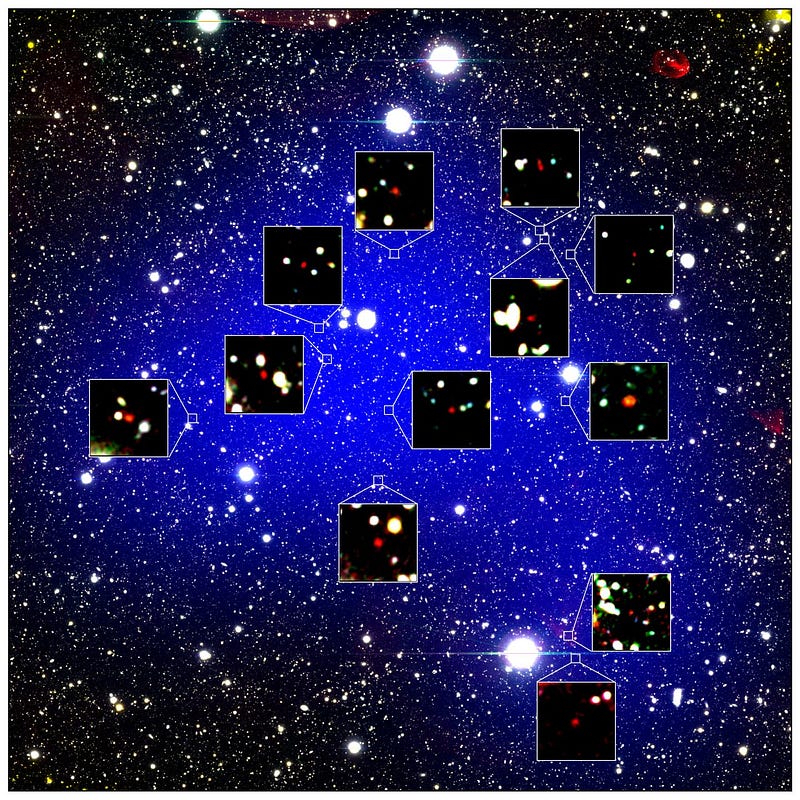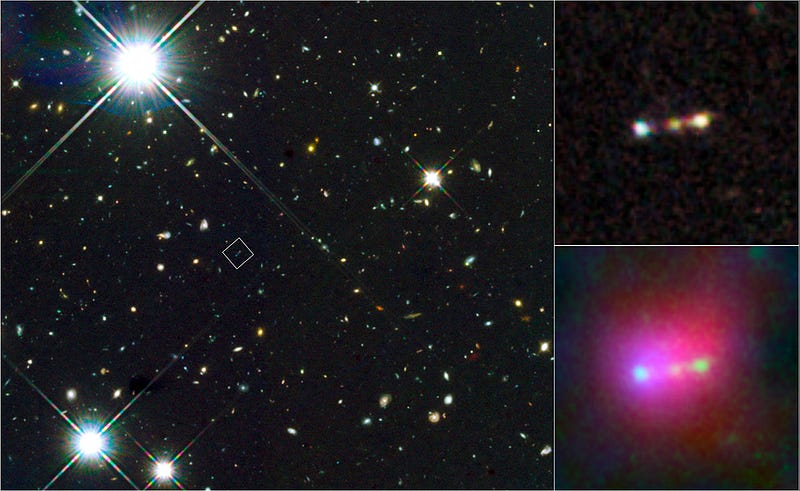# Early Universe Galaxies Discovered in Ancient Galactic Cluster
Written on
Chapter 1: Discovery of Ancient Galaxies
Astronomers have recently identified new members of a galactic protocluster, dating back 13 billion years. This marks the first observation of such a family of galaxies from the early Universe. Utilizing advanced telescopes like Subaru, Keck, and Gemini, researchers have detected these ancient galaxies, revealing insights into their origins.
A detailed examination of the protocluster has shed light on its significance.
Section 1.1: Insights from Advanced Telescopes
The protocluster, identified as z660D, is the oldest of its kind discovered to date. At the time this protocluster emerged, the Universe was merely 800 million years old, representing just six percent of its current age. While contemporary galaxy clusters can encompass hundreds or even thousands of galaxies, the formation of these structures remains largely enigmatic. To unravel this mystery, astronomers scrutinize protoclusters—dense collections of galaxies from the ancient Universe.

The z660D cluster is home to 12 galaxies, as illustrated in this image. Image credit: NAOJ/Harikane et al.
Yuichi Harikane from the National Astronomical Observatory of Japan remarked, “A protocluster is a unique and rare system, characterized by an exceptionally high density and challenging to locate. To tackle this issue, we leveraged the expansive field of view of the Subaru Telescope to survey a broad area of the sky for protoclusters.”
The Subaru telescope's mapping of the Universe uncovered a potential protocluster, z66OD, where ancient galaxies are clustered together at a density 15 times greater than what is typically observed for galaxies of that era. Follow-up observations conducted with the Keck telescope and the Gemini North Observatory in Hawaii confirmed the protocluster's ancient age.
Researchers note in The Astrophysical Journal, “Investigating large-scale structures is crucial for understanding galaxy formation, as evidence suggests that the properties of galaxies are influenced by their surroundings.”
Galaxies within z660D are forming at an astonishing rate—five times that of similar galaxies from that period.
Section 1.2: The Formation Rates of z660D Galaxies
Darko Donevski from the SISSA Institute in Italy explained, “The galaxies in z66OD exhibit high star formation efficiency, likely due to the massive nature of the system, which enables it to gather substantial amounts of gas, the essential material for star creation.”

Three galaxies within the Himiko cluster. Image credit: NASA, ESA, ESO, NRAO, NAOJ, JAO, M. Ouchi (University of Tokyo), et al.
Galaxy clusters are gravitationally bound groups of galaxies, and they are further organized into superclusters, the largest structures known in the Universe. One notable object in this cluster is Himiko, a massive galaxy discovered by the Subaru telescope in 2009 and named after a legendary queen of Japan.
An intriguing aspect of this cluster is that the galaxies are not densely packed around the largest member, which contradicts expectations based on gravitational effects.
Masami Ouchi from the National Astronomical Observatory of Japan and the University of Tokyo, who discovered Himiko, stated, “It is typical to find a protocluster near a significant object like Himiko, but we were surprised to find Himiko positioned on the edge of the protocluster, 500 million light-years from its center.”
Recent findings suggest that protoclusters may conceal massive galaxies obscured by enormous clouds of dust. Future observations utilizing ALMA (the Atacama Large Millimeter/submillimeter Array), a network of radio telescopes in Chile, might uncover hidden galaxies within this ancient family.
Chapter 2: Himiko—The Space Blob
The Subaru Telescope, situated on Mauna Kea in Hawaii, systematically surveys every area of the northern night sky. This 8.2-meter telescope, operated by the National Astronomical Observatory of Japan, has been mapping celestial bodies since 1999.
Just six years ago, astronomers using the Hubble Space Telescope detected three galaxies within a gas cloud surrounding Himiko.
“One of the most intriguing discoveries from the Subaru Telescope’s wide-field survey—Himiko—was uncovered in 2009. This enormous galaxy, named after an ancient Japanese queen, boasts a hot, glowing gaseous halo extending over 55,000 light-years,” reported Caltech in 2013.
Our own Milky Way belongs to a local group of approximately 50 galaxies, spanning around 10 million light-years, with our cluster containing about 1.3 billion times the mass of the Sun.
The first video, titled "JWST Found a Galaxy Like Our Milky Way in the Early Universe!", explores how the James Webb Space Telescope has identified a galaxy that bears similarities to our own.
The second video, "JWST has found MASSIVE galaxies in the early Universe which we can't explain", delves into the discovery of enormous galaxies from the early Universe that challenge existing explanations.
Chapter 3: The Legacy of Queen Himiko
Historical accounts and legends suggest that Queen Himiko ruled over the Yamatai region of Japan from 183 to 248 CE, during a time when Japan was fragmented into approximately 100 kingdoms. She is said to have united 30 of these city-states into a loose confederation, leading Chinese historians to refer to her as the ruler of all Japan.
Japanese myths depict Himiko as a reclusive leader who remained unmarried, residing in a fortress with 1,000 women serving her. She reportedly had a male liaison for diplomatic affairs, while her younger brother managed day-to-day governance.
Revered as a shamaness, Himiko had a deep connection to the spiritual realm, a characteristic common among leaders of her time in Japan. Upon her death, a hundred slaves were sacrificed to accompany her in her tomb. She remains a legendary figure among schoolchildren in Japan today.
Most of what we know about her comes from Chinese historical records. In 238, she sent emissaries to China, presenting gifts that included a title, a gold seal, and 100 bronze mirrors. This mission was followed by two subsequent trips in 243 and 247 CE, marking the last diplomatic interaction between the two cultures for nearly four centuries.
Just as Queen Himiko sought to connect her realm with China, studying the Himiko cluster may provide us with a deeper understanding of the early Universe.